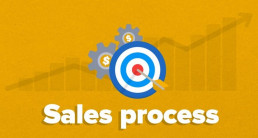
How to Build a Sales Process for the 9 Stages of the Sales Cycle How to Build a Sales Process for the 9 Stages of the Sales Cycle How to Build a Sales Process for the 9 Stages of the Sales Cycle
RAMY AYOUB
GOOGLE
text
How to Build a Sales Process for the 9 Stages of the Sales Cycle
Introduction:
The sales cycle serves as a roadmap for sales professionals, guiding them through the process of turning prospects into loyal customers. Each stage of the sales cycle plays a crucial role in building relationships, addressing customer needs, and ultimately closing the deal. In this comprehensive guide, we will explore the seven stages of the sales cycle, providing valuable insights and practical strategies to help you build an effective sales process that drives results.
Provide exceptional customer experiences: The foundation of generating referrals lies in delivering exceptional customer experiences. Focus on exceeding customer expectations, going above and beyond to solve their problems, and providing outstanding support. Satisfied customers are more likely to become advocates for your brand and refer you to their network.
Identify ideal referral sources: Take the time to identify individuals or organizations that are well-connected in your target market and have the potential to refer you to qualified prospects. This could include existing customers, industry influencers, partners, or even employees. Nurture relationships with these referral sources, demonstrating your value and the benefits their referrals will receive.
Ask for referrals strategically: When asking for referrals, be intentional and strategic. Timing is crucial, so choose the right moment when your customer is most satisfied with your product or service. Be clear in your request, explaining the type of leads you’re looking for and the value you bring to potential referrals. Make it easy for your customers to provide referrals by offering referral incentives or rewards.
Leverage digital channels: Utilize digital channels such as social media, email marketing, and online communities to amplify your referral efforts. Encourage satisfied customers to share their experiences on social platforms, provide testimonials, or participate in case studies. Utilize email campaigns to reach out to your customer base and remind them about your referral program.
Build a referral program: Create a structured referral program that incentivizes both referrers and referred leads. Offer rewards, discounts, or exclusive access to your loyal customers who refer new business your way. Make the referral process simple and seamless, providing clear instructions and tracking mechanisms to ensure proper attribution and recognition.
Express gratitude and reciprocate: When you receive referrals, express your gratitude to those who referred you and acknowledge their contribution. Consider reciprocating by referring business back to them whenever possible. This gesture strengthens relationships, encourages continued referrals, and fosters a supportive business community.
Chapter 1: Prospecting – Laying the Foundation for Success
Prospecting is the starting point of the sales cycle, where the journey to acquiring new customers begins. In this chapter, we will discuss the art of prospecting, exploring techniques for defining your ideal customer profile, leveraging multiple prospecting channels, conducting thorough research, and utilizing technology to streamline your efforts. By implementing effective prospecting strategies, you can identify and connect with prospects who are most likely to benefit from your product or service.
Chapter 2: Make Contact – Creating Meaningful Connections
Making contact with prospects is all about creating a positive first impression that piques their interest. In this chapter, we’ll cover strategies for initiating conversations, developing compelling messaging, and establishing rapport. By mastering the art of making contact, you can lay the foundation for building trust and fostering further engagement with your prospects.
Chapter 3: Qualify Your Prospect – Determining Fit and Potential
Qualifying prospects is a critical step to ensure you focus your efforts on the right opportunities. In this chapter, we’ll delve into effective qualification techniques, including researching prospects, asking targeted questions, and evaluating their needs and budget. By qualifying your prospects, you can determine their fit with your ideal customer profile and prioritize your resources accordingly.
Chapter 4: Nurture Your Prospect – Building Relationships for Success
Nurturing prospects involves cultivating relationships and building trust over time. In this chapter, we’ll explore the importance of personalized communication, providing value through educational content, and maintaining consistent follow-ups. Discover how to nurture prospects effectively to stay top of mind and position yourself as a trusted advisor throughout their buying journey.
Chapter 5: Present Your Offer – Articulating Value and Benefits
Presenting your offer is a pivotal stage where you showcase the unique value your product or service brings to the table. In this chapter, we’ll discuss techniques for crafting a compelling value proposition, tailoring your presentation to address prospects’ pain points, and utilizing persuasive storytelling to captivate their attention. By effectively presenting your offer, you can differentiate yourself from the competition and increase the chances of converting prospects into customers.
Chapter 6: Overcome Objections – Turning Challenges into Opportunities
Objections are a natural part of the sales process, and overcoming them requires finesse and confidence. In this chapter, we’ll provide strategies to handle common objections, demonstrate empathy, address concerns, and reinforce the value of your offering. Learn how to turn objections into opportunities for further engagement and showcase your ability to meet your prospects’ needs.
Chapter 7: Close the Sale – Sealing the Deal
Closing the sale is the ultimate goal of the sales cycle. In this chapter, we’ll explore different closing techniques, effective negotiation strategies, and how to create a sense of urgency to encourage prospects to make a buying decision. You’ll gain insights into successfully closing deals and ensuring a positive customer experience.
Chapter 8: Follow-Up – Building Post-Sale Relationships
The sales cycle doesn’t end with closing the sale. In this chapter, we’ll discuss the importance of post-sale follow-up and how it contributes to customer satisfaction and retention. We’ll explore strategies for maintaining ongoing communication, delivering exceptional customer service, and identifying opportunities for upselling or cross-selling.
Chapter 9: Asking for Referrals – Expanding Your Network and Boosting Sales
Expanding your network and generating referrals is a powerful way to fuel your sales efforts and drive business growth. In this final chapter, we’ll explore the art of asking for referrals. We’ll discuss strategies for leveraging your existing customer base, building strong relationships, and maximizing word-of-mouth marketing to attract high-quality leads.
Remember, generating referrals is an ongoing effort that requires nurturing relationships, delivering exceptional experiences, and actively seeking opportunities to expand your network. By incorporating referral generation into your sales process, you can tap into the power of trusted recommendations and significantly boost your sales effectiveness.
Conclusion: Building a successful sales process is a dynamic and iterative journey that aligns with the seven stages of the sales cycle. From prospecting to closing the sale, and beyond, each stage plays a vital role in establishing meaningful connections, understanding customer needs, and converting prospects into loyal customers.
By implementing the strategies outlined in this comprehensive guide, you’ll be well-equipped to navigate the sales cycle effectively. Remember to continuously refine and adapt your sales process based on feedback, data, and market dynamics. Embrace the art of prospecting, make impactful contacts, qualify prospects diligently, nurture relationships, present compelling offers, overcome objections, close deals, follow up diligently, and harness the power of referrals to fuel your sales growth.
Now, armed with this knowledge, it’s time to put theory into practice and embark on your journey toward sales success.




